mobile View, to the German Version tap the flag 

In that times when the activitie of the Post and Mail Service belonged to the sovereign tasks of a country, the postal flag was often a to the national flag similar flag. On land, it marked at least the location of a postal office and higher departments of Post and Mail Service as a post office flag. At sea, it marked postal ships, also sometimes used as a jack (bow flag). On merchant ships it could as a postal signal flag point out at that fact, that there is mail on board. Today, most of the postal systems are privatized worldwide, so that it is no longer a sovereign task, but a commercial undertaking which is no longer marked by a special flag. There is also the fact that the most frequented postal service today is air freight. For the above reasons, the postal flag in sea shipping on the high seas will hardly be to seen.
Quelle/Source: nach/by: Wikipedia (D), Jürgen Kaltschmitt

German postal flags
In the German countries the transport of mail (post-sovereignty) was initially in the hands of the rulers, who passed the transport of the mail as a privilege and as fief to vassals. In 1597 emperor Rudolf II. issued a mail law, the so-called Postregal, for the entire territory of the German Empire, and founded in this way the Kaiserliche Reichspost (Imperial Mail), and gave it as an hereditary dignity to the family of Thurn and Taxis, who became general postmasters and remained in it until the end of the Holy Roman Empire of German Nation in 1806. In 1695 the family was raised to imperial princes. After 1806, the Thurn-and-Taxis-Mail became a private company with post-sovereignty until 1867 in some countries of the German Confederation. From 1819, these countries were the Electorate of Hesse, the Grand Duchy of Hesse, Nassau, Saxony Weimar Eisenach, Saxony Meiningen, Saxony Coburg-Gotha (from 1825), the Principalities of Reuss Senior Line and Reuss Junior Line, Schwarzburg-Rudolstadt and Schwarzburg-Sondershausen, the Free Citiy of Frankfurt, the Principalities of Hohenzollern-Hechingen and Hohenzollern-Sigmaringen, Lippe-Detmold, Schaumburg-Lippe and the Kingdom of Wurttemberg. Wuerttemberg leaved the Thurn-and-Taxis-Mail in 1851 and took over the post-sovereignty itself. In other German countries the post-sovereignty belonged to the state, so in Baden, Bavaria, Brunswick, Bremen, Hamburg, Hanover, Luebeck, Mecklenburg-Schwerin, Mecklenburg-Strelitz, Oldenburg, Saxony, Schleswig-Holstein, and Prussia. In 1850 the Thurn-und-Taxis-Mail joined the German-Austrian postal union, which was not welcomed in Prussia and caused Wuerttemberg to leave the Thurn-and-Taxis-Mail. In the German War of 1866/1867 the headquarters of the Thurn-and-Taxis-Mail in Frankfurt was occupied by Prussian troops, and was in 1867 forced to cede the post-sovereignty. The states of Brunswick, Bremen, Hamburg, Luebeck, Mecklenburg-Schwerin, Mecklenburg-Strelitz, Oldenburg, Prussia and Saxony and the other states of the former Thurn-and-Taxis-Mail were unified by mail into the North German Mail Distict. Prussia had previously taken over the mail in Hanover, Nassau and Schleswig-Holstein. With the founding of the German Empire in 1871, the German Imperial Mail (Deutsche Reichspost) was created, which was responsible for all countries of the empire, except Bavaria and Wuerttemberg, which retained their post-sovereignty until 1920. After the Second World War were founded the two German states FRG and GDR in 1949. In the FRG, the German Federal Post Office was established in 1950 and the Deutsche Post of the GDR in the GDR. With the connection of the GDR and the FRG on 03.10.1990 both Postsysteme to the German Federal Post Office were merged. On 1st of January in 1994, the German Federal Post Office was privatized.
Quelle/Source: nach/by: Wikipedia (D), Jürgen Kaltschmitt

The flag of the German Imperial Postal Service (also: German Reichspost, Imperial Post) was present in public as a post office flag when it was hoisted on Sundays and holidays. In 1892, a new postal flag was introduced, which was oriented towards the other official flags of the German Empire. It showed beneath the golden imperial crown a golden post horn with a black-white-red cords (tying) and similarly colored tassels.
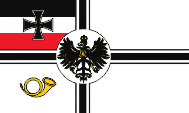
1871–1892,
Flag of the German Imperial Postal Service,
ratio = 3:5,
Quelle/Source: nach/by: Jürgen Kaltschmitt



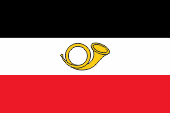
1871–1892,
Jack (bow flag) of postal ships,
ratio = 2:3,
Quelle/Source: nach/by: Wikipedia (DE)



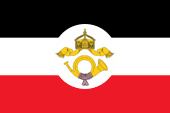
1892–1918,
Flag of the German Imperial Postal Service,
ratio = 2:3,
Quelle/Source: nach/by: Jürgen Kaltschmitt




1892–1918,
Post horn of the German Imperial Postal Service,
Quelle/Source nach/by: By Fornax (Own work) [CC
BY-SA 3.0 or Public domain], via Wikimedia Commons - adapted by author of flaggenlexikon.de
Quelle/Source: Jürgen Kaltschmitt, Volker Preuß, Wikipedia (DE)

The economic situation in the German Empire was difficult after the First World War, and it had been saved wherever it was possible. Thus the history of the black-red-golden postal flags began with a provisional. In this way, the imperial postal flag was reworked, the post horn became removed and its cords and tassels golden colored and placed in the middle of the red stripe of the black-red-golden flag.
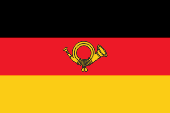
1919–1920,
Flag of the German Imperial Postal Service,
ratio = 2:3,
Quelle/Source: nach/by: Jürgen Kaltschmitt



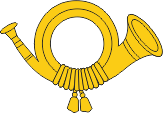
1919–1920,
Post horn of the German Imperial Postal Service,
Quelle/Source: nach/by: Jürgen Kaltschmitt
The cabinet meeting of the imperial gouvernment on 1st of September in 1919 decided to create a new postal flag, its shape was fixed on 27th of September in 1919 and was published on 15th of October in 1919. The post horn was redesigned, and it was placed in white in the center of the red stripe of the black-red-golden flag. In this form, the flag was used until 31st of July in 1921.
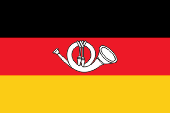
1920–1921,
Flag of the German Imperial Postal Service,
ratio = 2:3,
Quelle/Source: nach/by: Jürgen Kaltschmitt




1920–1921,
Post horn of the German Imperial Postal Service,
Quelle/Source: nach/by: Jürgen Kaltschmitt
On 11th of April in 1921, the Imperial President issued the "Order on the German Flags". Thus stands in Article 8: "The imperial postal flag has the lengthwise stripes like the national flagg, in the middle of the red stripe, which is wider by a fifth of the bordering stripes, a golden-yellow post horn with golden-yellow cords and two gold-yellow tassels, the mouthpiece moved towards the flagpole. Ratio of height to length of the bunting is 2 to 3". The Regulation came into force on 31st of July in 1921. This flag served as a model for the flag of the German Federal Post Office after the Second World War.
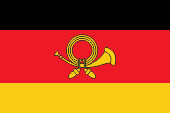
1921–1933,
Flag of the German Imperial Postal Service,
ratio = 2:3,
Quelle/Source: nach/by: Jürgen Kaltschmitt



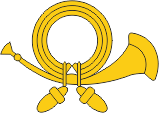
1921–1933,
Post horn of the German Imperial Postal Service,
Quelle/Source: nach/by: Jürgen Kaltschmitt
Quelle/Source: Jürgen Kaltschmitt, Volker Preuß, Wikipedia (DE)

In the flag history of the "Third Reich" are to differ two timespans. The first phase, between 1933 and 1935 is characterized by the ousting or redesign of the unpopular black-red-golden flags and the re-introduction of their respective black-white-red counterparts. A complete re-introduction of the imperial flags occured not because of political reasons. The second phase of the flag history of the "Third Reich" began actually at the end of the year 1934, as the empire's president Hindenburg died. Hitler, hitherto empire's chancellor, took the function self on and named hisself not more empire's president, but "leader". All the control was now concentrated in one hand and the national socialists ruled unrestricted. Not only the state hisself, but even his heraldic symbolism goes in this way through a policization in the year 1935. The party flag of the NSDAP (swastika flag) became now the exclusive national empire's and merchant flag, and all other flags were now redesigned in the design of the NSDAP. The swastika-symbolism was now omnipresent.
The new imperial postal flag was introduced by the "Provisional Rules of Flag Guidance from 31st of March in 1933, Section I, Number 1" of the Imperial President, Imperial Chancellor and Imperial Minister of the Interior. In principle it is the postal flag of the old empire, but without a crown.
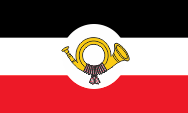
1933–1935,
Flag of the German Imperial Postal Service,
ratio = 3:5,
Quelle/Source: nach/by: Jürgen Kaltschmitt




1933–1945 (1947?),
Post horn of the German Imperial Postal Service,
Quelle/Source nach/by: By Fornax (Own work) [CC
BY-SA 3.0 or Public domain], via Wikimedia Commons - adapted by author of flaggenlexikon.de
In consequence of the imperial flag law from the 15th of September in 1935 and with the decree of the guidance of the imperial official flag of the imperial minister of the Interior from 31st of October in 1935 and by the regulation of the Leader and Imperial Chancellor about the imperial official flag from 31st of October in 1935 (RGBl I, p. 1287) the postal flag was abolished in principle. The postal services had to use the general official lag.
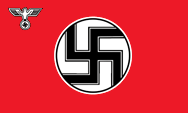
1935–1945,
Official flag,
ratio = 3:5,
legal notice
Quelle/Source: nach/by: Flags of the World
Quelle/Source: Jürgen Kaltschmitt, Volker Preuß, Wikipedia (DE)

After the Second World War, an own post service was set up in Saarland on the initiative of the French occupation forces. The Saarpost began its work in 1947. The logo was a stylized post horn with the addition of the word "Post-Saar", which was used in golden yellow on a green background. The color of the postal service in Saarland was green, like at the French Post (PTT, Postes Tèlégraphes et Télécommunications). Green were the motor vehicles, buses, mailboxes and also the bicycles.

1947-1954,
Logo of Saarpost,
Quelle/Source: nach/by: saar-nostalgie.de



From about 1954 employees of the Saarpost used inofficially a similar of the in Germany usual post horn. However, the color green instead of yellow was farther used for the postal service.
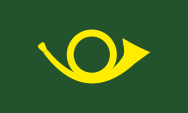
1954-1957,
Unofficial logo of Saarpost,
Quelle/Source: nach/by: Jürgen Kaltschmitt



With the accession of Saarland to the FRG on 1st of January in 1957 the Saarpost ended. It was integrated into the Bundespost as "Oberpostdirektion (OPD) Saarbrücken".
Quelle/Source: Jürgen Kaltschmitt, saar-nostalgie.de, Volker Preuß

After the Second World War the postal service had to be rebuilt under the supremacy of the occupying powers. There was not yet a uniform mail, and of course, no postal flags. From 1947, a uniform post horn was used in the Soviet Occupation Zone, from 1948 in all other occupation zones (except in Saarland) as the symbol of the postal service. In 1949 the two German states FRG and GDR were founded. In the GDR was established the Deutsche Post of GDR. With the connection of the GDR to the FRG on 3rd of October in 1990 both postal systems were merged to the German Federal Post Office.
From 1947 to 1955 there was initially only a yellow pennant with the post horn in it. It was only used on vehicles.
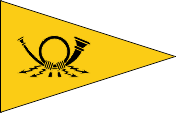
1947-1955,
Postal flag,
Quelle/Source: nach/by: Jürgen Kaltschmitt



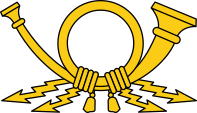
1947–1949, Post horn German Postal Service,
1949–1990, Post horn German Post of GDR,
Quelle/Source: Jwnabd [Public domain, GFDL or
CC BY-SA 3.0], via Wikimedia Commons
The GDR introduced a postal flag in 1955, which showed the golden yellow post horn in the middle of the red stripe on a black-red-golden flag with equally wide stripes. However, post offices were no longer flagged, only higher departments, such as the district administration or the ministry.
In 1973, the postal flag was abolished, the postal services had now to use the flag of the GDR.
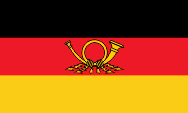
1955–1973,
Flag of German Post of GDR,
ratio = 3:5,
Quelle/Source: nach/by: Jürgen Kaltschmitt



In 1975, a new postal flag was introduced, which, however, did not have to mark the place of postal authorities. It was used on vehicles that had been used for postal services, which were not painted in the typical postal yellow, to mark them as vehicles in the service of postal authorities.
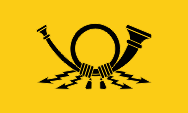
1975–1990,
Flag of German Post of GDR,
original ratio = 2:3,
Quelle/Source: nach/by: Jürgen Kaltschmitt



Quelle/Source: Jürgen Kaltschmitt, Volker Preuß, Wikipedia (DE)

After the Second World War the postal service had to be rebuilt under the supremacy of the occupying powers. There was not yet a uniform mail, and of course, no postal flags. In the western occupation zones was founded the German Post Office (Deutsche Post) in 1947 as the successor of the German Reichspost, and in 1950 it was renamed in German Federal Post Office. From 1947, a uniform post horn was used in the Soviet Occupation Zone, from 1948 in all other occupation zones (except in Saarland) as the symbol of the postal service. In 1949 the two German states FRG and GDR were founded. In the GDR was established the Deutsche Post of GDR. With the connection of the GDR to the FRG on 3rd of October in 1990 both postal systems were merged to the German Federal Post Office. On 1st of January in 1994, the German Federal Post Office was privatized.
On 7th of June in 1950, the Federal President, the Federal Chancellor and the Minister of the Interior of the FRG issued the "Order on the German Flags". There stands in Article 4: "The federal postal flag has the lengthwise stripes like the federal flag, in the middle of the red stripe, which is wider by a fifth of the bordering stripes, a golden post horn with gold-colored cords, two gold-colored tassels and four gold-colored flashes, the mouthpiece moved towards the flagpole. Ratio of height to length of the bunting is 3 to 5". The Regulation came into force on 14th of June in 1950.
The flag of the German Reichspost of 1921 served as a model. Because the red middle-stripe of the flag was wider, the previous post horn was slightly adapted. The tassels and the flashes pointed more steeply downwards.
With it were flagged post offices, but also higher departments such as Oberpostdirektionen (upper postal administrations) or also the ministry.
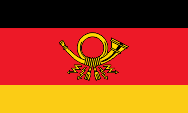
1950–1994,
Flag of the German Federal Post Office,
ratio = 3:5,
Quelle/Source: nach/by: Jürgen Kaltschmitt




1947–1950, Post horn German Postal Service,
Quelle/Source: Jwnabd [Public domain, GFDL or CC BY-SA 3.0, via Wikimedia Commons
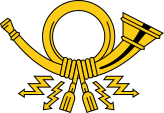
1950–1994, Post horn German Federal Post Office,
Quelle/Source: Jwnabd [Public domain, GFDL or
CC BY-SA 3.0], via Wikimedia Commons
By the 4th Implementing Regulation to the Flag Law (postal signal flag for sea vessels) of 5th of December in 1954 (BGBl. II 1952, p. 403) was introduced a postal signal flag. It was a golden triangular pennant (stander) with a red-black border and the post horn in the middle. All German sea and merchant ships that had mail on board, had to hoist it at the foretop. By a regulation of 26th of September in 1990 (BGBl I, p. 2144) the postal signal flag was abolished.
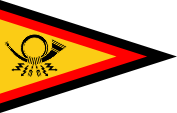
1951–1990,
Postal signal flag,
Quelle/Source: By Fornax [Public domain], via Wikimedia Commons



Quelle/Source: Jürgen Kaltschmitt, Volker Preuß, Wikipedia (DE)

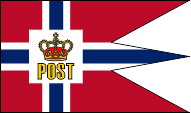
Postal flag of Norway

Postal flag of Japan
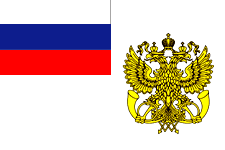
Postal flag of Russia
Quelle/Source: wikimedia
























































